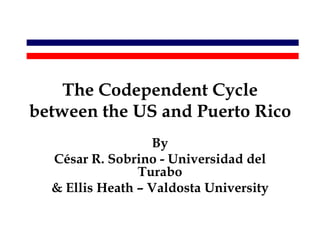Presentation coidine 2012 cesar sobrino
- 1. The Codependent Cycle between the US and Puerto Rico By César R. Sobrino - Universidad del Turabo & Ellis Heath – Valdosta University
- 2. Motivation ? According to Mundell (1961), for optimum currency areas, economies should have synchronized common cycles. ? According to Frankel and Rose (1997;1998), trade intensity and synchronicity of business cycles are endogenous. ? This statement raises the issue whether currency areas lead to synchronized business cycles. – Data of Puerto Rico is relevant. – Puerto Rico belongs the US currency area.
- 3. Objectives ? Find a common cycle between US output and PR output. – A sychronized common business cycle. – A non-synchronized common business cycle. – Using Vahid and Engle’s (1997) test ? Policy implications about findings.
- 4. Previous literature ? Frankel and Rose (1997, 1998), Calderon, Chong and Stein (2007); Artis, Chouliarakis, Harischandr (2011); Bordo and Hiebling (2011); Artis and Okubo (2011); Inklaar, Jo-A- ping and de Haan (2008); Shin and Wang (2003); Rose (2008) for EMU; and, De Pace (2011). ? Herrera (2003) Mexico and US share a common trend and common cycles since NAFTA adoption Vahid and Engle (1993)
- 5. Common feature literature ? For stationary series – Engle & Kozicki (1993) ? For non-stationary series Conditional to cointegration – Vahid & Engle (1993)-Common cycle – Vahid & Engle (1997)- Codependent cycle
- 6. Methodology & Data ? VECM ? Vahid and Engle’s (1997) statistic ? Data: – Fed St. Louis, US RGDP (annual) – Conference Board: US CEI (quarterly) – Junta de Planificacion: RGDP (annual), CEI (quarterly). – Bureau of Labor Service (BLS): both unemployment rates- quarterly series
- 7. Real GDPs 1947-2009 30.5 24 30.0 23 29.5 22 29.0 21 28.5 28.0 20 50 55 60 65 70 75 80 85 90 95 00 05 Shortcoming: Annual and fiscal year side) US RGDP in logs (right-hand PR RGDP in logs (left-hand side)
- 8. CEIs and U. Rates Coincident Economic Indexes Unemployment rates (1992=100) (1976q1-2012q2) (1970q1-2007q2) 5.0 28 4.8 24 20 4.6 12 16 4.4 10 12 8 4.2 8 6 4.0 4 3.8 2 1970 1975 1980 1985 1990 1995 2000 2005 1980 1985 1990 1995 2000 2005 2010 Log of CEIUS Log of CEIPR URATEUS URATEPR
- 11. Vahid and Engle’s (1997) test
- 12. Robustness
- 13. Codependent vectors Notes: Standard errors in parentheses.
- 14. Conclusions ? US and Puerto Rico outputs share a non synchronized common cycle. Codependency at one quarter. ? Compared to Mexico, PR is less integrated to the US in the short run. – Merchant Act (Jones Act) ? Look for some monetary mechanism with NY Fed for smoothing GDP falls (countercyclical monetary policies).
- 15. References ? Frankel, J.A., Rose, A.K., 1997. Is EMU more justifiable ex post than ex ante? European Economic Review, 41, 753-760 ? Frankel, J.A., Rose, A.K., 1998. The Endogeneity of the Optimum Currency Area Criteria, The Economic Journal, 108, 1009-1025. ? Engle, R. and S. Kozicki (1993) “Testing for Common Features”, Journal of Business and Economic Statistics 11: pp. 369-396. ? Herrera, Jorge (2004) Business Cycles in Mexico and The United States: Do They share common movements? Journal of Applied Economics, Vol. VII, No. 2, 303-323 ? Mundell, R. (1961) Optimun currency areas, American Economic Review, 51, 667-655. ? Vahid, F & Engle, R. (1993). "Common Trends and Common Cycles," Journal of Applied Econometrics, vol. 8(4), pages 341-60, ? Vahid, F. and R. Engle (1997), “Codependent Cycles”, Journal of Econometrics 80: 199-221.















